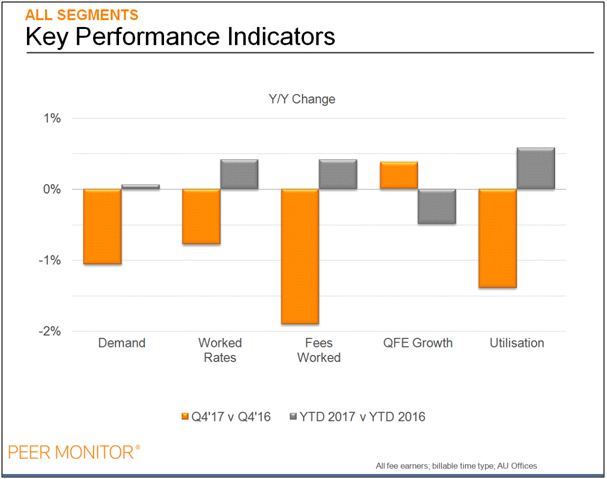Law firms throughout Australia saw a decline across most segments in the previous quarter, widening the gap between the Big 8 law firms and their Large counterparts.
Australian law firms across most segments struggled with a decline in demand, worked rates, fees worked and utilisation in the fourth quarter of 2017, but the latest Thomson Reuters Peer Monitor Report reveals that these decreases were mostly limited to Large law firms1, while the Big 82 enjoyed modest growth.
After a healthy third quarter, with 4.4 per cent growth, the legal market suffered a reduction in overall demand – measured as total billable hours worked – with a 1.1 per cent drop in Q4’17.
This decrease was segment-specific, with the Big 8 law firms enjoying a slight increase in demand of 0.7 per cent in Q4’17, while the Large segment saw their demand decline by 2.5 per cent. As further evidence of this widening gap, the Big 8 also saw a 0.5 per cent increase in average worked rates3 – compared to Q4’16 – while Large firms’ worked rates shrank by an average of 1.8 per cent.
Utilisation the biggest area of difference
The starkest contrast between the segments was seen in utilisation, which measures the relationship between the number of qualified fee earners (lawyers including partners) employed and billable hours worked by a firm.
According to the report, utilisation grew by 1.1 per cent on average among firms in the Big 8 (compared to a 6.6 per cent increase in Q3’17). The Large firm segment saw a 3.4 per cent drop in average utilisation, down from a positive 3 per cent growth in Q3’17.
But despite an overall slow in the last quarter of the year, the report also shows some areas of improvement in the Australian legal market.
All firm collected revenue showed a slight 0.8 per cent rise from Q4’16 to Q4’17, which continues a trend of modest revenue growth for the past three years.
Meanwhile, in terms of demand by practice area, Corporate M&A, Corporate General and Construction all showed slight growth, however Dispute Resolution and Banking and Finance declined.

Big 8 firm growth not a surprise
Commenting on the industrial decline and what it means for Large law firms, Carl Olson, Product Management Director ANZ at Thomson Reuters Legal, said: “Demand has been gradually declining as the year wears on, and expenses are climbing at a pace not seen for several years.
“While stronger growth in the Big 8 is helping to offset these drags on profitability, [Large law] firms may be running out of runway for much more rate growth, leaving them to cope with slower demand and higher costs,” he said.
It is perhaps no surprise that the Big 8 firms are ploughing ahead and continuing to survive in an industry that has faced much disruption in recent years – players such as Allens, Corrs Chambers Westgarth and Herbert Smith Freehills recognised the critical need for greater client focus and innovation early on.
These firms took action and made headlines in 2016 with various initiatives that challenged the Australian legal industry, which may be why they are enjoying better performance results now compared to their Large counterparts.
The road ahead appears challenging for Large law firms. Those making efforts to improve and streamline their practices, and those that have stuck with a tried-and-tested approach alike, may find their strategies further tested if market trends continue downward into the next quarter.
[1] The remaining 10 firms by lawyer count of Australian offices in the Peer monitor program, averaging 218 lawyers.
[2] The largest 8 firms by lawyer count of Australian offices in the Peer monitor program, averaging 634 lawyers.
[3] Reflects hourly rate after negotiated discounts from the Standard/Rack Rate.


